Research - (2020) Advances in Dental Surgery
Awareness on Ayurvedic Medicine for Healthy Lifestyle Among South Indian Population A Survey
Nandini Palanivel, Vishnu Priya V* and Gayathri R
*Correspondence: Vishnu Priya V, Department of Biochemistry, Saveetha Dental College and Hospitals, Saveetha Institute of Medical and Technical Sciences (SIMATS), Saveetha University, Chennai, India, Email:
Abstract
Ayurvedic knowledge originated in India more than 5,000 years ago and is often called the “Mother of All Healing.”It stems from the ancient Vedic culture and was taught for many thousands of years in an oral tradition from accomplished masters to their disciples. Some of this knowledge was set to print a few thousand years ago, but much of it is inaccessible. The principles of many of the natural healing systems now familiar in the West have their roots in Ayurveda, including Homeopathy and Polarity Therapy. There has been an increased global interest in traditional medicine. Efforts to monitor and regulate traditional herbal medicine are underway. Ayurveda, the traditional Indian medicine, remains the most ancient yet living traditions. Although India has been successful in promoting its therapies with more survey and science-based approach, it still needs a more extensive survey and evidence based. Increased side effects, lack of curative treatment for several chronic diseases, high cost of new drugs, microbial resistance and emerging, diseases are some reasons for the renewed public interest in complementary and alternative medicines. The aim of the study is to create awareness on ayurvedic medicine to lead a healthy lifestyle among the South Indian population. This study is a questionnaire-based survey administered to the participants through a survey planet link. Numerous nutraceutical combinations have entered the international market through the exploration of ethnopharmacological claims made by different traditional practices. This survey gives an overview of the Ayurvedic system of medicine for a healthy lifestyle among the South Indian population.
Keywords
Ayurveda, Traditional medicine, Survey planet, Online survey
Introduction
Ayurveda has the distinction of being the "oldest medical system known to man and the oldest and most comprehensive spiritual teachings in the world". Ayurveda is based on the principle of maintaining a balance between the interrelated relationships within the body and mind. It helps the patient to understand the benefits of knowing their body and mind and to live in an intimate relationship with nature. Ayurveda is a gift of Gods to mankind which was communicated to the saints and sages of India through deep meditation. Vedas have topics on health and the use of various herbs to cure the diseases [1]. Ayurvedic literature has remedies for age-related diseases like memory loss, osteoporosis, diabetic wounds, etc. for which no efficient medicine is available in modern therapy [2]. Ayurvedic formulations should be standardized as they are also found to have equal effects as of English medicines [3]. Use of Ayurveda increased for treating various diseases and it was divided into eight specific branches of medicine. In addition, Atreya- the school of physicians and Dhanvantri-the school of surgeons originated. The Chinese, Tibetans, Greeks, Romans, Egyptians, Afghanistanis, and Persians came to India to learn ayurvedic principles of healing and treatment [4]. Besides this, Ayurveda became popular in Europe as well and it formed the foundation of the European tradition in medicine. Paracelsus, the father of modern medicine (1600 AD) was also adopted from Ayurveda [5].
Ayurveda is based on the fundamental principle of preventing and treating illness, maintaining a balance in the body, mind, and consciousness through proper drinking, diet, and lifestyle, as well as herbal remedies. Even today Ayurvedic medicine maintains its holistic approach to health and treatment of diseases [6]. Ayurveda identifies that there are three basic types of energy in the body mainly Vata, pitta and Kapha. Vata is the energy of movement. It controls bodily functions associated with motion, including blood circulation, breathing, blinking, muscle and tissue movements, heartbeat and movements of cytoplasm and cell membrane [7]. A balanced state of Vata energy will result in creativity and vitality. Imbalanced state, Vata creates fear and anxiety. Pitta is the energy of digestion and metabolism. It controls the body's metabolic systems, including digestion, absorption, assimilation, nutrition, metabolism and temperature. In a balanced state, pitta leads to contentment and intelligence while in an imbalanced state, pitta causes ulcers and arouses anger. Kapha is the energy of lubrication and structure. This energy controls the growth of the body. It supplies water to all body parts, moisturizes the skin, lubricates the joints and bones and maintains the immune system. Balanced condition of Kapha is required for the expression of love and forgiveness [8]. Ayurvedic medicine, has been used for centuries as a memory enhancer, nootropic, antistress, anxiolytic, antidepressant, anticonvulsant, tranquilizing and sedative agent [4]. Equilibrium between the Doshas and their governing factors are required for proper health, which is the central dogma of Ayurveda. Every individual has a unique composition of tridoshas in their body. Usually one of the doshas will be prominent, others will be moderate and the third will be least prominent. Vata is more dominant under normal conditions and controls the other two energy principles, Pitta and Kapha. Any imbalance in a dosha will lead to various kinds of ailment and their symptoms. Food, Drugs and Lifestyle are the important factors that maintain the balance in a human body [9]. Imbalance in the central dogma of Ayurveda can be caused by external factors like unhealthy diet, bad habits, more mental stress and climatic changes. Equilibrium or balance is regained for maintaining health in Ayurveda by implementing a new lifestyle, appropriate diet and use of herbal drugs. There has been an upsurge in demand for the Phyto-pharmaceutical products of Ayurvĕda in western nations, because of the fact that the synthetic drugs are considered to be unsafe. Due to this many national and multinational pharmaceutical companies are now concentrating on manufacturing of Ayurvĕdic Phyto-pharmaceutical products [10]. Previous studies on cancer biology, nanomaterials, herbal products have motivated me to pursue this current research which is useful to our community. The aim of the study is to create awareness on ayurvedic medicine to lead a healthy lifestyle among the South Indian population.
Materials and Methods
Questionnaire survey was conducted among the south Indian population. A self-administered questionnaire based on Ayurvedic medicine for healthy lifestyle among South Indian population was prepared. The questionnaire was distributed through an online “Survey Planet '' link. The study population included 109 South Indian populations. The participants were explained about the purpose of the ayurvedic medicine and benefits of the study purpose in detail. The study was approved by the Institutional Review Board, Saveetha Dental College. The questions were carefully studied, and corresponding answers were marked by the participants. The data was collected and statistically analysed. The results were obtained in the form of a pie chart.
Results and Discussion
The results were obtained and statistically analysed. From Figure 1 it is evident that only 82% (90 members) of the population were aware of the ayurvedic medicine and the rest 17.4% (19 members) were unaware of it. From Figure 2 it was observed that 45% (50 members) of the population were aware that Ayurvedic medicine is expensive and the rest were not aware that Ayurvedic medicine is expensive. Figure 3 represents whether ayurvedic medicine is effective or not for the South Indian population. It is seen that 85% (91 members) of the participants say that ayurvedic medicines are effective and 14.2% (15 members) of the population say that Ayurvedic medicines are not effective for the South Indian population.
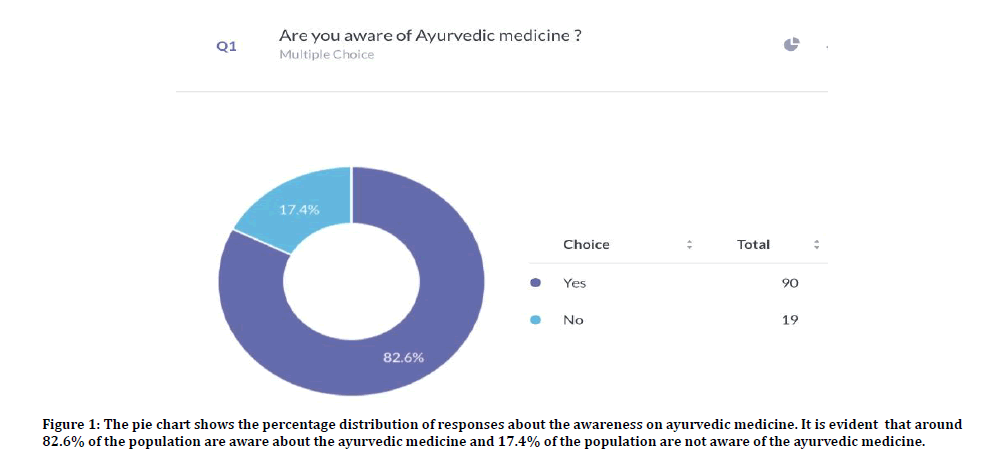
Figure 1: The pie chart shows the percentage distribution of responses about the awareness on ayurvedic medicine. It is evident that around 82.6% of the population are aware about the ayurvedic medicine and 17.4% of the population are not aware of the ayurvedic medicine.
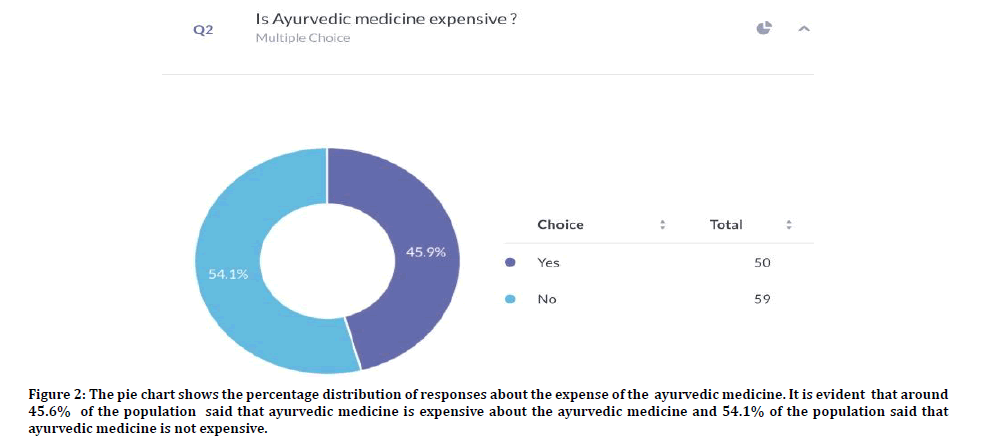
Figure 2: The pie chart shows the percentage distribution of responses about the expense of the ayurvedic medicine. It is evident that around 45.6% of the population said that ayurvedic medicine is expensive about the ayurvedic medicine and 54.1% of the population said that ayurvedic medicine is not expensive.
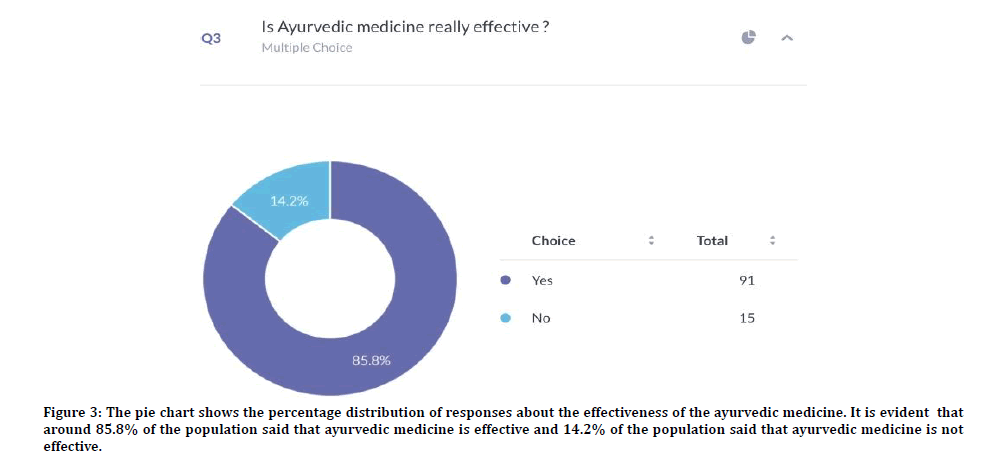
Figure 3: The pie chart shows the percentage distribution of responses about the effectiveness of the ayurvedic medicine. It is evident that around 85.8% of the population said that ayurvedic medicine is effective and 14.2% of the population said that ayurvedic medicine is not effective.
From previous studies it was found that ayurvedic medicine was very effective to lead a healthy lifestyle among the South Indian population. A total of 150 participants opted ayurvedic medicine among a total population of 400 participants [11]. From Figure 4 it is known that only 62.3% (40 members) of the participants say that ayurvedic medicine is harmful, the rest say that ayurvedic medicine is not harmful. Figure 5 represents that one can take both Ayurvedic medicine and modern medicine together, in that 51.4% (51 members) of the population agreed.
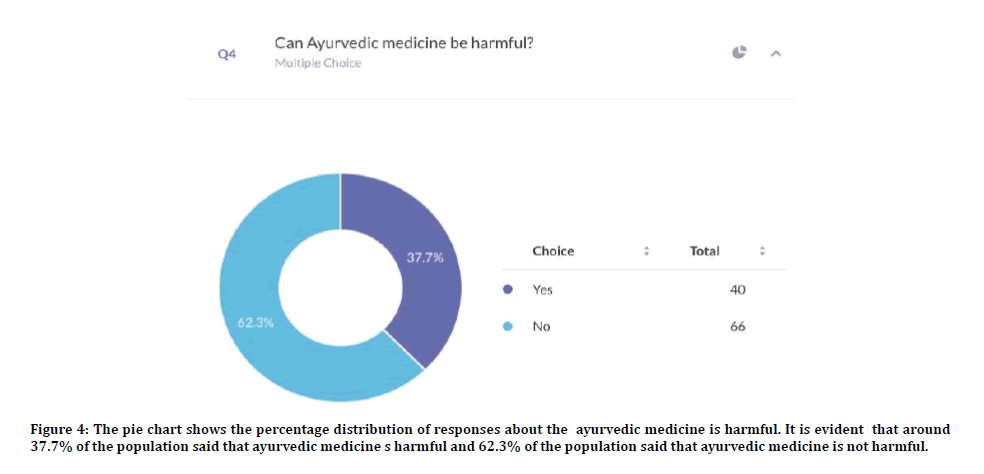
Figure 4: The pie chart shows the percentage distribution of responses about the ayurvedic medicine is harmful. It is evident that around 37.7% of the population said that ayurvedic medicine s harmful and 62.3% of the population said that ayurvedic medicine is not harmful.
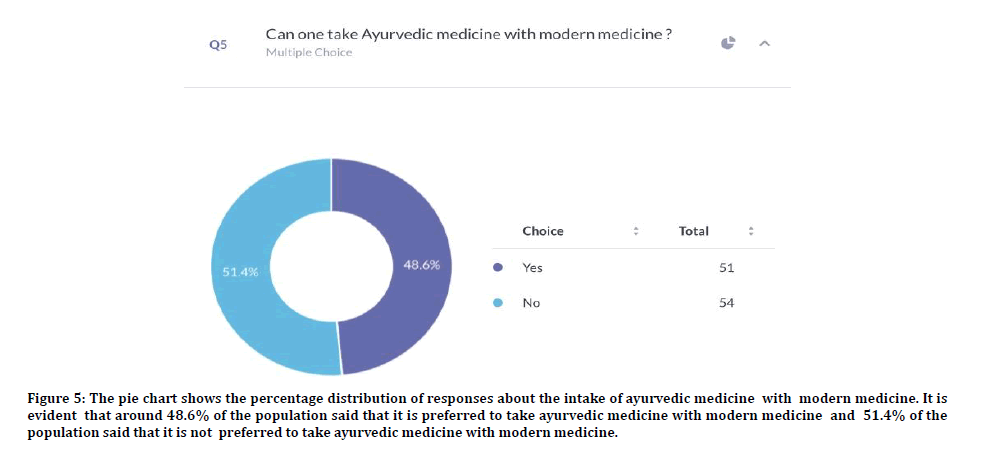
Figure 5: The pie chart shows the percentage distribution of responses about the intake of ayurvedic medicine with modern medicine. It is evident that around 48.6% of the population said that it is preferred to take ayurvedic medicine with modern medicine and 51.4% of the population said that it is not preferred to take ayurvedic medicine with modern medicine.
From Figure 6 it is evident that it is possible to maintain health and treatment of disease in Ayurveda which was agreed by 82.9% (87members) population. The rest 17.1% (18 members) say that it is not possible to maintain health and treatment of diseases in Ayurveda. In Figure 7 the frequency of maintaining personal hygiene for healthy life while taking Ayurvedic medicine. It is seen that 87.6% (92members) prefer personal hygiene and the rest 12.4% (13 members) say it doesn’t matter. From Figure 8 it is understood that only 68.9% (73 members) of the participants do regular exercise while taking Ayurvedic medicine and the rest do not practice it. From Figure 9, 70.9% (73 members) of the population say that specific diet is required while taking ayurvedic treatment and 29.1%(39members) of the population does not maintain a proper diet while taking ayurvedic treatment. Figure 10 shows the people who have been under ayurvedic treatment, 62.1% (64 members) of the population have taken ayurvedic treatment, and 37.9% (39 members) of the population have not undergone any ayurvedic treatment. It is seen that only 69.9% (72 members) of the population says that they didn’t have any side effects due to the intake of the ayurvedic medicine and whereas 30.1% (31members) of the population says that they had side effects due to ayurvedic medicine (Figure 11).
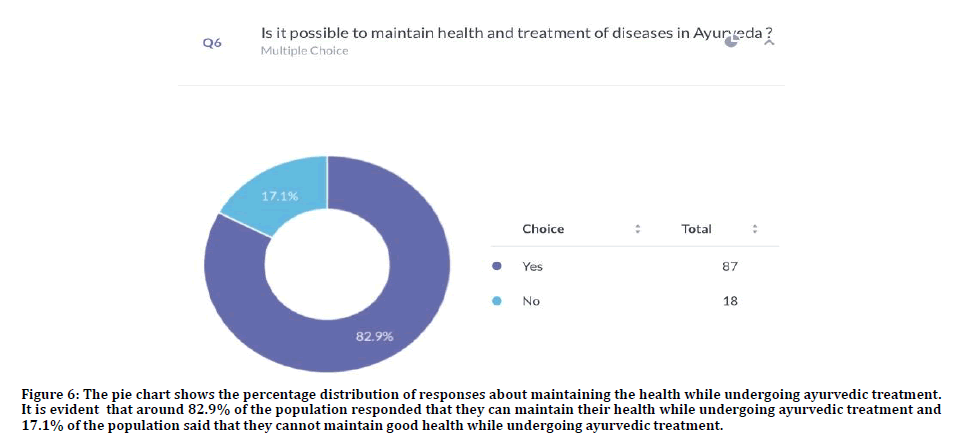
Figure 6: The pie chart shows the percentage distribution of responses about maintaining the health while undergoing ayurvedic treatment. It is evident that around 82.9% of the population responded that they can maintain their health while undergoing ayurvedic treatment and 17.1% of the population said that they cannot maintain good health while undergoing ayurvedic treatment.
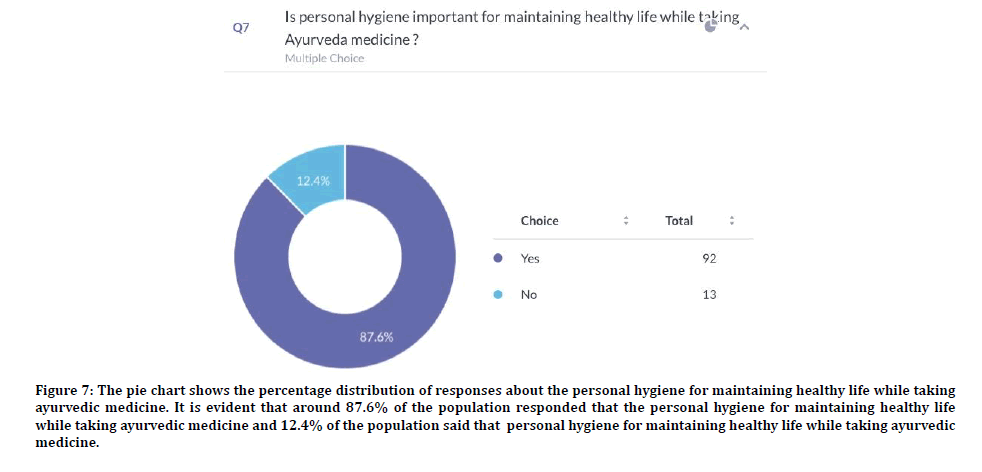
Figure 7: The pie chart shows the percentage distribution of responses about the personal hygiene for maintaining healthy life while taking ayurvedic medicine. It is evident that around 87.6% of the population responded that the personal hygiene for maintaining healthy life while taking ayurvedic medicine and 12.4% of the population said that personal hygiene for maintaining healthy life while taking ayurvedic medicine.
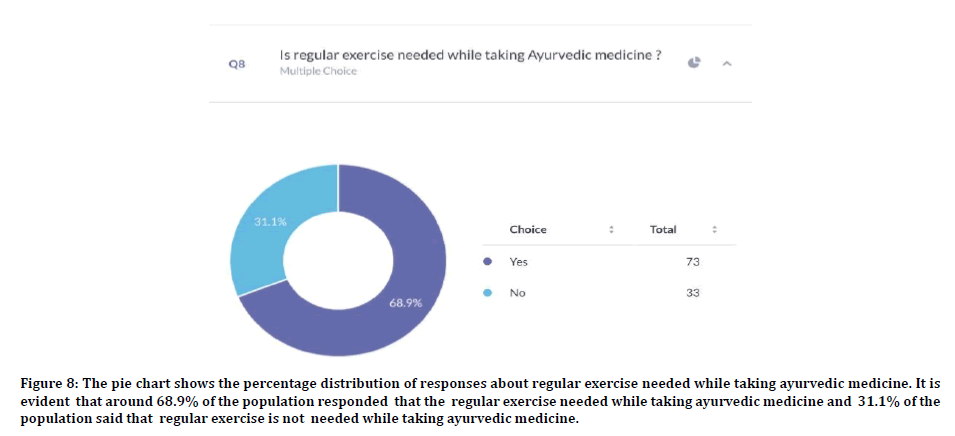
Figure 8: The pie chart shows the percentage distribution of responses about regular exercise needed while taking ayurvedic medicine. It is evident that around 68.9% of the population responded that the regular exercise needed while taking ayurvedic medicine and 31.1% of the population said that regular exercise is not needed while taking ayurvedic medicine.
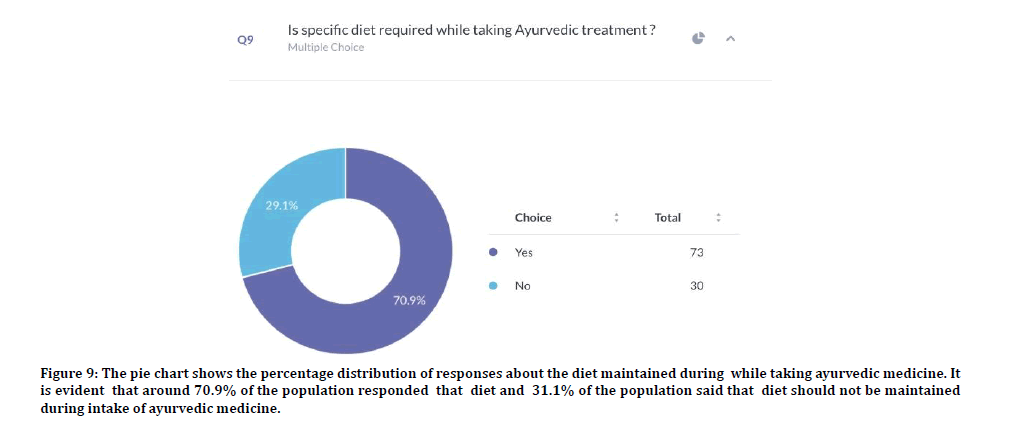
Figure 9: The pie chart shows the percentage distribution of responses about the diet maintained during while taking ayurvedic medicine. It is evident that around 70.9% of the population responded that diet and 31.1% of the population said that diet should not be maintained during intake of ayurvedic medicine.
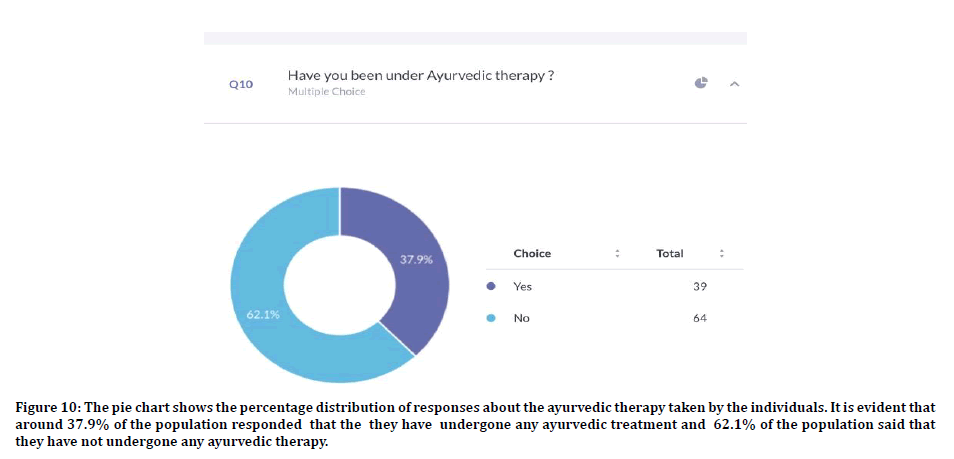
Figure 10: The pie chart shows the percentage distribution of responses about the ayurvedic therapy taken by the individuals. It is evident that around 37.9% of the population responded that the they have undergone any ayurvedic treatment and 62.1% of the population said that they have not undergone any ayurvedic therapy.
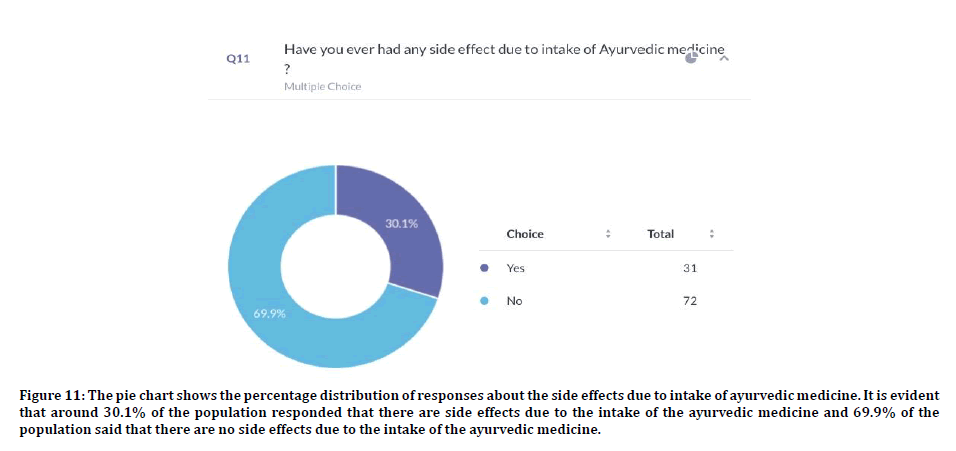
Figure 11: The pie chart shows the percentage distribution of responses about the side effects due to intake of ayurvedic medicine. It is evident that around 30.1% of the population responded that there are side effects due to the intake of the ayurvedic medicine and 69.9% of the population said that there are no side effects due to the intake of the ayurvedic medicine.
From Figure 12 it is evident that 60.6% (63 members) of the population’s mindset was ayurveda is the best medicine and 16.3% (17 members) of the population prefer homeopathy medicines and 20.2% (21 members) of the population says they prefer allopathy medicines and the rest of the population prefer unani and siddha. It is seen that 60% (63 members) of the population were aware of the side effects due to ayurvedic medicine and 40% (42 members) of the population were unaware of the side effects caused due to ayurvedic medicine (Figure 13). Figure 14 represents the reason to choose ayurvedic medicine, 77.1% (81 members) of the population says that it’s a natural source and 12.4% (13 members) said that its cost effective and the rest 10.5% (11 members) of the population said that it has less side effects.
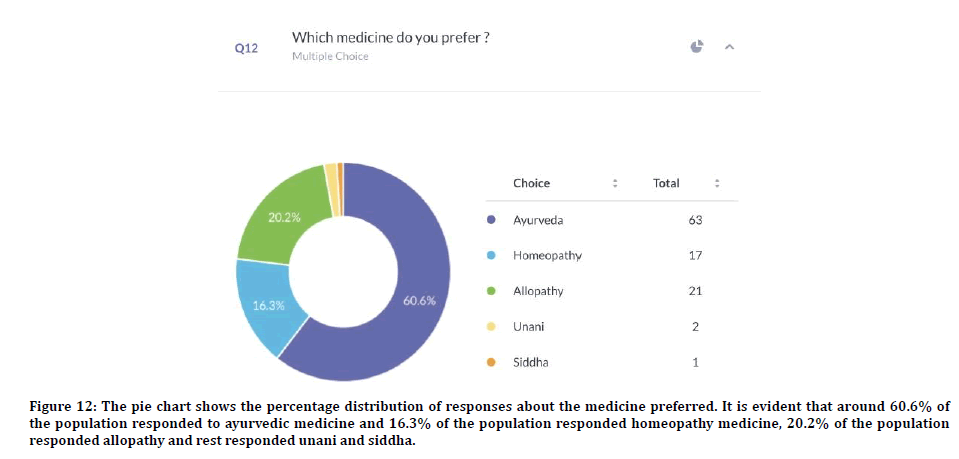
Figure 12: The pie chart shows the percentage distribution of responses about the medicine preferred. It is evident that around 60.6% of the population responded to ayurvedic medicine and 16.3% of the population responded homeopathy medicine, 20.2% of the population responded allopathy and rest responded unani and siddha.
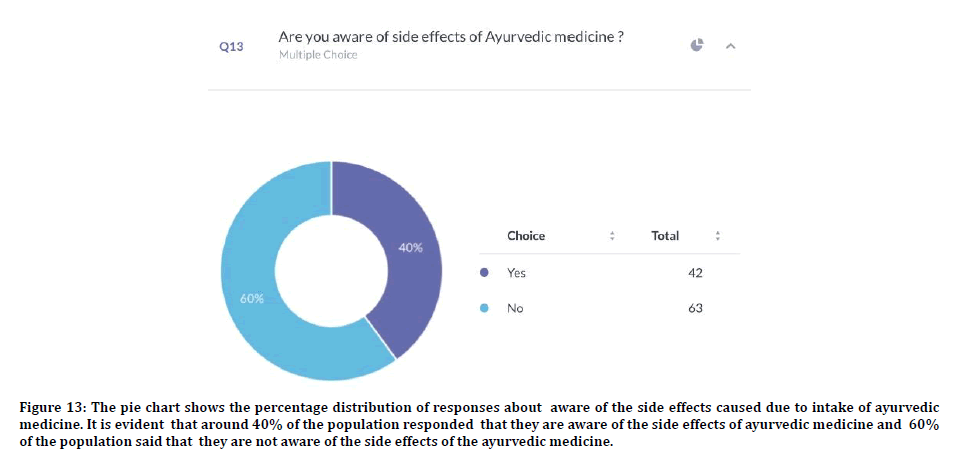
Figure 13: The pie chart shows the percentage distribution of responses about aware of the side effects caused due to intake of ayurvedic medicine. It is evident that around 40% of the population responded that they are aware of the side effects of ayurvedic medicine and 60% of the population said that they are not aware of the side effects of the ayurvedic medicine.
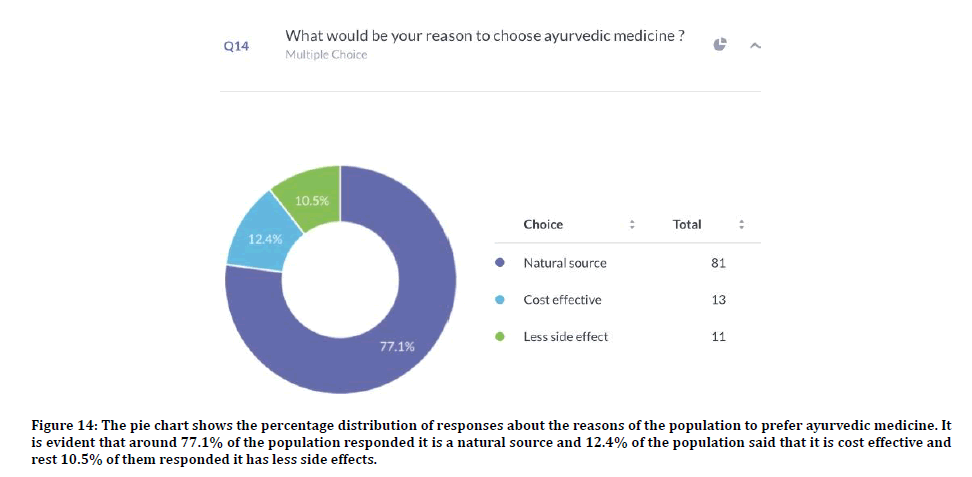
Figure 14: The pie chart shows the percentage distribution of responses about the reasons of the population to prefer ayurvedic medicine. It is evident that around 77.1% of the population responded it is a natural source and 12.4% of the population said that it is cost effective and rest 10.5% of them responded it has less side effects.
Conclusion
Overall, the study provides a glimpse of the ayurvedic medicine functions and benefits in modern lifestyle. Ayurvedic medicine aims to maintain and restore the body's own capability to have balance and fight with ailments like arthritis, obesity, hypertension. Ayurvedic medicine may help to lead a happy life through proper diet and lifestyle modifications.
Acknowledgement
The authors thank Saveetha Dental College for the support to complete this study.
Conflict of Interest
Conflict of interest declared as none.
References
- Aggarwal BB, Surh YJ, Shishodia S, et al. The molecular targets and therapeutic uses of curcumin in health and disease. Springer Science Business Media 2007.
- Das A, Kumar S, Raj S, et al. Positive influence of diet and lifestyle in management of obesity: a case study. Int J Res Ayurveda Pharma 2019; 10:97-99.
- Lalchhandama K. Science and technology for shaping the future of Mizoram. Allied Publishers 2017.
- Mukherjee PK, Kumar V, Kumar NS, et al. The ayurvedic medicine clitoria ternatea from traditional use to scientific assessment. J Ethnopharmacol 2008; 120:291-301.
- Pole S. Ayurvedic medicine: The principles of traditional practice. Elsevier Health Sciences 2006.
- Elaheebocus N, Mahomoodally MF. Ayurvedic medicine in Mauritius: Profile of ayurvedic outlet, use, sale, distribution, regulation, and importation. J Ethnopharmacol 2017; 197:195-210.
- Paul B, Masih I, Deopujari J, et al. Occurrence of resveratrol and pterostilbene in age-old darakchasava, an ayurvedic medicine from India. J Ethnopharmacol 1999; 68:71-76.
- Lahoti R, Mullapudi GP. Ayurvedic approach to restless leg syndrome: A case report. Indian J Ancient Med Yoga. 2018; 11:67–68.
- Telles S, Balkrishna A, Maharana K. Effect of yoga and ayurveda on duchenne muscular dystrophy. Indian J Palliative Care 2011; 17:169.
- Narayana A, Subhose V. Standardization of ayurvĕdic formulations: A scientific review. Bulletin Indian Institute History Med 2005; 35:21-32.
- Chopra A, Doiphode VV. Ayurvedic medicine: Core concept, therapeutic principles, and current relevance. Medical Clin 2002; 86:75-89.
Author Info
Nandini Palanivel, Vishnu Priya V* and Gayathri R
Department of Biochemistry, Saveetha Dental College and Hospitals, Saveetha Institute of Medical and Technical Sciences (SIMATS), Saveetha University, Chennai, IndiaCitation: Nandini Palanivel, Vishnu Priya V, Gayathri R, Awareness on Ayurvedic Medicine for Healthy lifestyle among South Indian Population a Survey, J Res Med Dent Sci, 2020, 8 (7): 212-219.
Received: 29-Sep-2020 Accepted: 26-Oct-2020 Published: 02-Nov-2020
